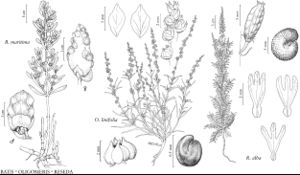Bataceae
Subshrubs; (halophytic); spines absent; largely glabrous. Stems: branches arching or prostrate; branchlets drooping or erect. Leaves (cauline), opposite, simple (each with a basal-abaxial appendage); stipules caducous, (paired, minute); petioles absent; blade (succulent), margins entire. Inflorescences axillary or terminal, conelike spikes (catkins) [lax and spikelike or solitary flowers]. Flowers unisexual, staminate and pistillate on different plants [same plant in different inflorescences], actinomorphic; bracts present. Staminate flowers each initially enclosed in sac splitting into 2 lobes (spathella); tepals 4 or 5, distinct, white, equal, base long-clawed [tapered]; androecium hypogynous; nectary glands absent; stamens 4 or 5, alternating with and longer than tepals; filaments distinct; anthers dehiscing by longitudinal slits. Pistillate flowers bracteate; tepals absent; pistil 1, 2-carpellate; ovary falsely 4-loculed; placentation basal-parietal; ovules anatropous, bitegmic; style absent; stigmas 2-lobed. Fruits drupaceous syncarps [drupes], ellipsoid. Seeds 1–4, narrow, flattened.
Distribution
s North America, Mexico, West Indies, Central America, n South America, Pacific Islands (Galapagos Islands, Hawaii, s New Guinea), n Australia.
Discussion
Genus 1, species 2 (1 in the flora).
Bataceae are warm-temperate, subtropical, and tropical, coastal halophytes. Because of their proclivity to inhabit saline habitats and because of morphological similarities to halophytic members of Chenopodiaceae, early taxonomists tended to place Bataceae in the Chenopodiales (Centrospermae). The absence of betalains (T. J. Mabry and B. L. Turner 1964), dissimilarity of sieve-element plastid types (H.-D. Behnke and Turner 1971), and dissimilar chromosome numbers (P. Goldblatt 1976) rule out that relationship. Phylogeneticists now accept Bataceae as a member of Brassicales (Capparales) based on the presence of glucosinolates (Mabry 1976) and myrosinase, and molecular similarities (J. E. Rodman et al. 1998). In Brassicales, there are similarities to the Australian Gyrostemonaceae and Salvadoraceae (B. Prijanto 1970; S. Carlquist 1978; Rodman et al.).
The fruits and seeds are water-dispersed. The succulent syncarps can float for one or two weeks before releasing the one-seeded pyrenes, which also can float up to three months before germinating after reaching land (H. B. Guppy 1903–1906, vol. 2).
